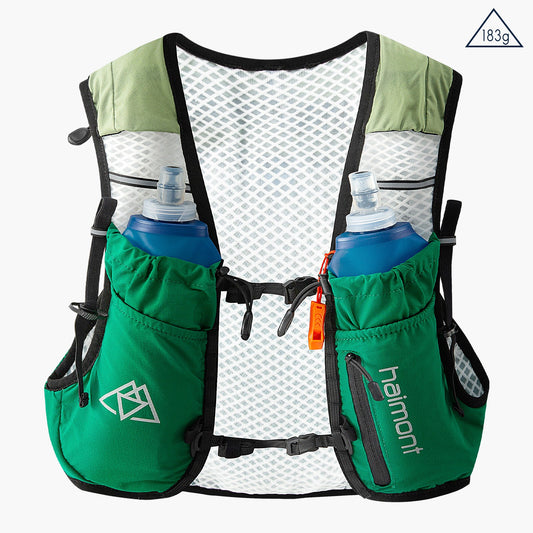Sistema HAIT: ¡La equipación más rápida para tus competiciones!

Llevamos la carrera contra el reloj en la sangre. Queremos medirnos con los demás, ser más rápidos y llegar primeros a la meta. Cuando suena el pistoletazo de salida, lo damos todo. ¡Hemos nacido para competir!
Para deportistas, por deportistas
En Haimont, obtendrás el paquete completo: desde el producto hasta consejos y trucos para tus carreras. Te daremos consejos sobre cómo prepararte mejor para tu carrera, y cómo entrenar y recuperarte. Obtén valiosos consejos de nuestros expertos para planificar la carrera y cómo ponerte en forma. También nos aseguramos de que conozcas los aspectos más destacados del calendario de carreras de 2024. ¡Súbete a la línea de salida con nosotros!
Sistema HAIT: Características destacadas del producto
Experiencia en carreras: para atletas, por atletas
Competiciones de trail running: lo más destacado de 2024
Sistema HAIT: Características destacadas del producto
Nuestra colección HAIT marca la diferencia cuando cada segundo cuenta. Ultraligera, técnica y repleta de características innovadoras, esta línea de competición altamente técnica está orientada a la velocidad de la cabeza a los pies.

Ultra HAIT Pole: Tu compañero de carrera
Agresivo y rápido: el bastón Ultra HAIT fue desarrollado en colaboración con el atleta de Haimont Hannes Namberger y puesto a prueba en las carreras ultra más exigentes del mundo. Descubra qué fue especialmente importante para Hannes durante el desarrollo y por qué el bastón Ultra HAIT es la primera opción para su próxima carrera.

Quitarse la mochila es cosa del pasado: el chaleco para correr HAIT, ultraligero y, al mismo tiempo, totalmente estable, tiene unas características técnicas impresionantes y mucho espacio para guardar el equipo. Puedes guardar tus bastones de forma rápida y segura en el práctico estuche.

Ultraligera y muy transpirable: la camiseta HAIT tiene una impresionante libertad de movimiento y se siente realmente cómoda incluso en días calurosos.
Ultraligeros y altamente transpirables: estos ingeniosos pantalones cortos con mallas integradas también evitan las rozaduras y tienen una alta puntuación en cuanto a gestión ideal de la humedad.
El trail running tiene muchas más subidas y bajadas que las carreras en ruta. Debido al movimiento ascendente continuo, se utiliza más el cuádriceps, que es el músculo más grande que se encuentra delante del muslo. Por lo tanto, los corredores también necesitan ejercitar este músculo tanto como sea posible. El trail running y los maratones son eventos de larga distancia, por lo que la cantidad de carrera no es menor.
Si las condiciones lo permiten, puedes optar por ir a las montañas cercanas a entrenar para estimular tus cuádriceps y dejar que tu cuerpo se adapte gradualmente a los cambios de frecuencia cardíaca al escalar.
Para los principiantes, bajar cuesta abajo es bastante difícil. Es un trabajo que requiere tanto valentía como tecnología. Es necesario tener cierta experiencia en competición y práctica antes de poder dominarlo y observar el punto de apoyo de la bajada mientras se corre.
En resumen, los principiantes deben recordar que "no hay que ser demasiado agresivos en la montaña, ni demasiado imprudentes en los descensos". Si se va demasiado deprisa en la montaña, se acabará agotado en la última etapa. Es mejor bajar lentamente, de lo contrario es fácil torcerse el tobillo y lesionarse. Si se quiere bajar como los maestros, hay que seguir perfeccionando las habilidades.
La mayoría de las estrategias de carrera de maratón se basan en el ritmo, mientras que el concepto de ritmo no es tan fuerte en el trail running. Las estrategias de carrera de trail running se formulan básicamente en función de las subidas, ondulaciones y condiciones de la carretera de la pista.
En una carrera de trail running no te moverás a un ritmo constante. Incluso en distancias más cortas como 25 kilómetros, necesitas saber dónde están las subidas de la pista antes de la carrera, qué tipo de superficies hay en la pista, si son asfaltadas, de grava o embarradas, y si las subidas son caminos de tierra de montaña o escaleras de piedra. Solo de esta manera podrás dominar el ritmo de la carrera y estimar el tiempo de llegada según tu capacidad.
Cuando llega la temporada de trail running, ¿cómo quieres empezar tu primera carrera de trail running?
- Elegir una selección da como resultado una actualización de página completa.





